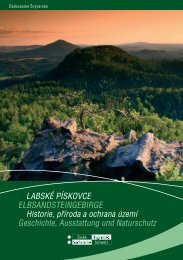ABSTRACT BOOK Sandstone Landscapes ... - Sandstones.org
ABSTRACT BOOK Sandstone Landscapes ... - Sandstones.org
ABSTRACT BOOK Sandstone Landscapes ... - Sandstones.org
You also want an ePaper? Increase the reach of your titles
YUMPU automatically turns print PDFs into web optimized ePapers that Google loves.
PTomáš Tichý and Marcela MácováInstitute of Botany, Academy of Science of the Czech Republic, CZ-252 43 Průhonice, Czech Republic(Tomáš Tichý: tichy@ibot.cas.cz; Marcela Mácová: macova@ibot.cas.cz)Dendroclimatic comparison of invasive Pinus strobus and native Pinus sylvestris growing in theCzech Republic on ecological and geographical gradientIntroductionAlien white pine (Pinus strobus) was introduced from North America to the plantations in theCzech Republic at the end of the 18 th century, with intensive planting beginning in the twentieth century. Atpresent white pine reproduces naturally and suppresses the native vegetation by forming densemonocultural stands and a thick layer of needle litter in some regions of the country, especially insandstone rock areas.One of the studies presented compares the responses to temperature and precipitation levels of thenative Scots pine and the invasive white pine growing in the Elbe River <strong>Sandstone</strong> Mountains (NationalPark) as a region heavily affected by spontaneous regeneration of Pinus strobus. On a transect across a rivervalley we selected sites with contrasting environmental variables including differences in direct solarradiation, soil depth and water availability.The second study was focused on dendroclimatology of these two species in three regions of theCzech Republic differing in their abiotic characteristics and a degree of Pinus strobus regeneration in theplantations and spreading into the forests of other species.Material and methodsIn the transect across a valley, standard dendroclimatological methods were used for thecomparison; these included application of a response function model and partial correlation of monthlyaverage temperatures and monthly precipitation with tree-ring widths. A transect was chosen for the studyarea across a narrow valley in the plateau of the Elbe <strong>Sandstone</strong> at altitudes between 200-250 m a.s.l. Threesites were included in the transect: shaded position near the bottom of the valley with relatively deep soilwith high water availability and two positions on the rim of the valley, both with southern and northernexposition, with almost no soil and higher potential direct solar radiation.The response function analysis, the moving response function analysis and the pointer yearsanalysis were used in the comparison of tree regions with old plantations of Pinus strobus and native orplanted Pinus sylvestris forests:1) the Elbe <strong>Sandstone</strong> Mountains in the North of the Czech Republic, with massive invasion of white pine;2) the Elbe River Lowland in the centre, with regeneration of white pine increasing in recent years;3) the Jindrichuv Hradec region in the South, with almost no spontaneous regeneration of white pine.Results and discussionThe response function analysis of the trees from the transect showed that both species werepositively sensitive to June-July precipitation in all the chosen habitats, although Scots pine was lesssensitive near the bottom of the valley. Both species were also found to be positively sensitive to higherFebruary-March temperatures, due to the possibility of late-winter frost damage. Scots pine reactedstrongly in all habitats while white pine reacted weakly high above the bottom of the valley on the edges ofthe sandstone plateau, but strongly near the bottom of the valley where there is a risk of inversion frosts.The two pine species differed in their reaction to temperatures in the September of the preceding tree-ringgrowth season. The most striking finding is that white pine reacted negatively to high temperatures whileScots pine showed no reaction. This could be due to the negative influence of high temperatures on buddevelopment which takes place in white pine later than in Scots pine. The temperature reaction in whitepine is weak near the bottom of the valley where direct solar radiation in September is reduced by shadingfrom the valley rim.The basic features of response of both species described above occured at all the plots in threestudy areas on the geographical gradient. There were differences in the intensities of the reaction andseveral uncommon further reactions: the most important were positive influence of high precipitation inprevious summer to both species in the Jindrichuv Hradec region.The pointer years analysis showed a strong common response of both species in all study areas toextremely dry summer in 1976. Other pointer years were different for each area and species.




